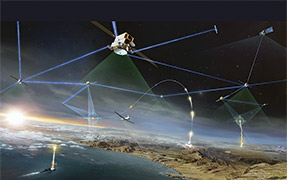Computer modeling optimizes photodynamic therapy
Photodynamic therapy (PDT) uses light of a specific wavelength to activate a drug within a tissue, and a subsequent photochemical reaction kills nearby cells. The US Food and Drug Administration has already approved specific forms of PDT for treating esophageal and non-small cell lung cancer, and research shows that the technique can be effective against skin cancer.1 Nonetheless, PDT faces several obstacles, including difficulties in planning and monitoring the photodynamic process, and the variability of outcomes.2 The procedure for planning treatment with traditional-radiation therapy, such as x-rays, is termed dosimetry: the determination by scientific methods of the amount, rate, and distribution of radiation emitted from a source of ionizing radiation.3 Similar dosimetry for non-ionizing radiation, such as the light used in PDT, is not widely available. Moreover, complicated optical properties of tissues and variability in the light source make it difficult to monitor and verify the amount of radiation that reaches the drug.
Light dosimetry for PDT requires the calculation of the photon dose within and surrounding the lesion. In a first approximation, the light source is assumed to have adequate energy to activate the drug in the targeted tissue, and that all of the tissues are relatively the same. However, optical properties of tissues vary widely,4 and assumptions about these characteristics might result in miscalculations of the optimal treatment. There are four parameters for optically defining tissue: the scattering coefficient; the absorption coefficient; the anisotropy, which is the cosine of the photon-scattering angle; and the refractive index. These parameters determine the reflection, transmission, and photon density in the treatment area. Figure 1 is a photomicrograph of an esophageal wall. It shows various layers composed of different cellular structures, each of which has different optical properties.

Lihong Wang and Steven L. Jacques—both then working at the M.D. Anderson Cancer Center at the University of Texas, Houston—wrote one of the first programs to optically model layered tissue.4 With this program, a user specified various tissue and source parameters to calculate light fluence within a volume. More recently, others5–7 investigated the use of computer modeling in an animal model of prostate cancer, where tissue properties were measured experimentally so that the theoretical and actual light dose during PDT could be compared. From our experience, Breault Research Organization's (Tucson, AZ) Advanced System Analysis Program (ASAP®) creates excellent computer models of tissues and light sources, and hence enables a photon dosimetric for PDT.
We focus on developing the necessary tools—using physical models of tissue and light sources—for robust and biologically based light dosimetry for clinical PDT. ASAP creates ‘virtual’ structures with geometric and optical properties that resemble tissue. It also lets us study various tissue properties and source geometies prior to clinical therapy. For example, Figure 2 shows a simplistic model of a human esophagus, which was constructed as a three-layer tissue: a 300μm-thick epithelium (inside), a 1mm-thick mucosa (middle), and a 2mm-thick muscle layer (outer). Optical properties used for each layer have been published previously. A typical PDT light source—a cylindrical diffuser 2cm in length and 1mm in diameter—lies at the center of the structure. Sources such as these can be measured prior to use for power output and field inhomogeneities, and this data is used to create the model.

Sources used for light delivery in PDT vary depending upon the location and morphology of the lesion, but they are typically fiber-optic catheters terminated with cylindrical diffusers or lenses for flat-field applications. Nonetheless, these sources are imperfect, and can exhibit inhomogeneous emission profiles. ASAP can apply functions, such as apodization, to an ideal virtual source to alter its emission profile to match imperfect emitters. This program can also measure the light dose within the layered structure relative to changes in source geometry. Figure 3 shows how fluence within the tissue depends on the placementc of the diffuser: centered in the structure in Figure 3(a), and offset from the center by 1.4mm in Figure 3(b). Visual and numerical data show the flux density within the model.

Light dosimetry for PDT is complicated, because it depends on the optical properties of local tissues and the spatial output of the light source. Consequently, simply assuming the values of these parameters can cause miscalculations in the planned light dose, which would lead to suboptimal therapy. By using ASAP to construct virtual models of complicated tissue structures and light sources, clinical scientists can measure and predict the effect of these variables prior to treatment. As PDT becomes more widely used for cancer therapy, a robust and accurate photon dosimetric needs to be implemented.



